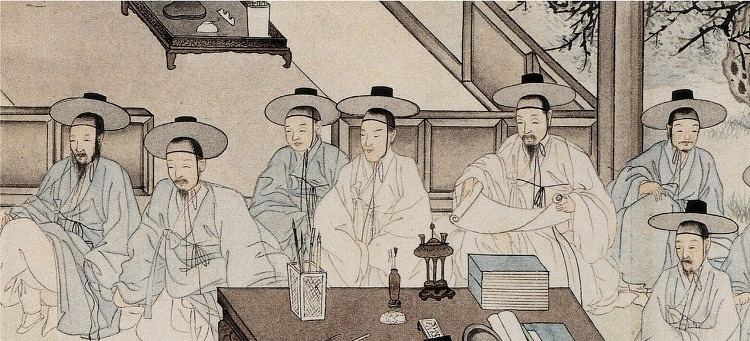Hangul 시조 Revised Romanization Sijo | Hanja 時調 McCune–Reischauer Sijo | |
 | ||
Sijo (/ˈʃiːdʒoʊ/; [ɕʰidʑo]) is a Korean poetic form that emerged in the Goryeo period, flourished during the Joseon Dynasty, and is still written today. Bucolic, metaphysical and cosmological themes are often explored. The three lines average 14-16 syllables, for a total of 44-46: theme (3, 4,4,4); elaboration (3,4,4,4); counter-theme (3,5) and completion (4,3). Sijo may be narrative or thematic and introduces a situation in line 1, development in line 2, and twist and conclusion in line 3. The first half of the final line employs a “twist”: a surprise of meaning, sound, or other device. Sijo is often more lyrical and personal than other East Asian poetic forms, and the final line can take a profound turn. Yet, “The conclusion of sijo is seldom epigrammatic or witty. A witty close to a sentence would have been foreign to the genius of stylized Korean diction in the great sijo periods. ”
Contents
Examples
Sijo, unlike some other East Asian poetic forms, frequently employs metaphors, puns, allusions and similar word play. Most poets follow these guidelines very closely although there are longer examples. An exemplar is this poem by Yun Seondo (1587–1671) :
Yun Seondo also wrote a famous collection of forty sijo of the changing seasons through the eyes of a fisherman. Following is the first verse from the Spring sequence; notice the added refrains in lines 2 and 4.
Either narrative or thematic, this lyric verse introduces a situation or problem in line 1, development (called a turn) in line 2, and a strong conclusion beginning with a surprise (a twist) in line 3, which resolves tensions or questions raised by the other lines and provides a memorable ending.
Korean poetry can be traced at least as far back as 17 BC with King Yuri's Song of Yellow Birds but its roots are in earlier Korean culture (op. cit., Rutt, 1998, "Introduction"). Sijo, Korea's favorite poetic genre, is often traced to Confucian monks of the eleventh century, but its roots, too, are in those earlier forms. One of its peaks occurred as late as the 16th and 17th centuries under the Joseon Dynasty. One poem of the sijo genre is from the 14th century:
Sijo is, first and foremost, a song. This lyric pattern gained popularity in royal courts amongst the yangban as a vehicle for religious or philosophical expression, but a parallel tradition arose among the commoners. Sijo were sung or chanted with musical accompaniment, and this tradition survives. The word originally referred only to the music, but it has come to be identified with the lyrics.
Note: The English adaptations of verses by Yun Seondo and U Tak are by Larry Gross (op. cit.) The English adaptation of the verse by Hwang Jin-i is by David R. McCann (op. cit.); Some of the information on the origins of sijo are cited from The Bamboo Grove: An Introduction to Sijo, ed. Richard Rutt (U. of Michigan Press, 1998); Kichung Kim's An Introduction to Classical Korean Literature: From Hyangga to P'ansori'; and Peter H. Lee.
In English
In 1986 the journal Poet dedicated an issue to "classic" Korean sijo translated into English by Korean-American Kim Unsong (a.k.a. William Kim). This was followed by Kim's Classical Korean Poems (Sijo) in 1987, Sijo by Korean Poets in China, and Poems of Modern Sijo (a collection of his originals) in the mid-1990s. They found a devoted audience in American theWORDshop publisher Dr. Larry Gross and Canadian haiku poet Elizabeth St. Jacques. As a result, a volume of original English-language sijo (Around the Tree of Light) by St. Jacques appeared in 1995. Soon after, Gross launched the first issue of Sijo West with St. Jacques as assistant editor. It was the world's first poetry journal dedicated to English-language sijo and caught on well with poets dedicated to haiku and other forms of Asian verse.
Sijo West folded (in 1999, after five ground-breaking issues) reportedly due to health problems and tragedies with Gross. St. Jacques reemerged with online postings known as Sijo Blossoms (circa 2001), which, apparently, has since evolved into the Sijo In The Light section of her Poetry In The Light website. Sijo In The Light, like the defunct Sijo West, featured original English-language sijo, as well as essays and reviews. Gross, meanwhile, has maintained a significant presence for sijo on his website Poetry in theWORDshop, which includes translations from Korean masters as well as original contributions by contemporary poets. Gross moderated a Yahoo! discussion group, sijoforum.
